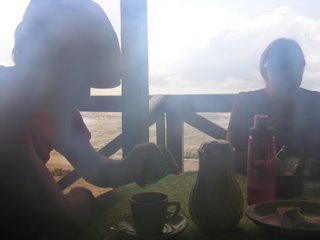 We woke up to a lovely breakfast and our first glimpse of the beauty of our sur- roundings.
We woke up to a lovely breakfast and our first glimpse of the beauty of our sur- roundings.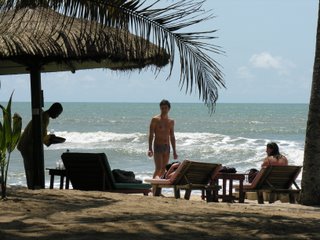 We laid on the beach for a little while, and had a little swim and then we got dressed and headed off down the beach to Anomabo town for a bite of lunch and to hire a car to take us to Cape Coast.
We laid on the beach for a little while, and had a little swim and then we got dressed and headed off down the beach to Anomabo town for a bite of lunch and to hire a car to take us to Cape Coast.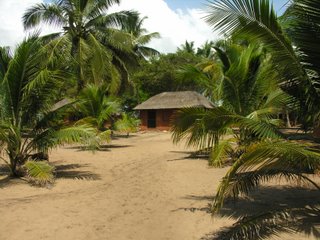
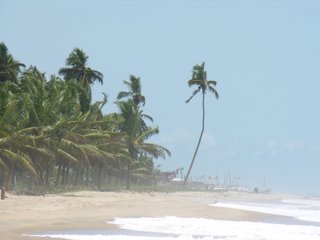 Once we got past the edge of the resort and closer into town we started to notice poop on the beach, the guide book warned of 'fresh turds' but I didn't really think we'd see any.
Once we got past the edge of the resort and closer into town we started to notice poop on the beach, the guide book warned of 'fresh turds' but I didn't really think we'd see any. 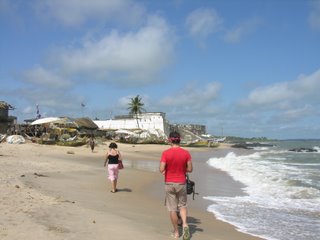 As we headed down the beach we saw vultures eating out of garbage piles, and lots of duggout fishing boats up close. I commented to the others that if my mother could see where I was she'd have a heart attack, then we all laughed our asses off.
As we headed down the beach we saw vultures eating out of garbage piles, and lots of duggout fishing boats up close. I commented to the others that if my mother could see where I was she'd have a heart attack, then we all laughed our asses off.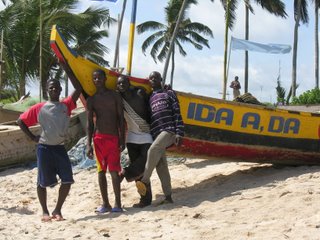
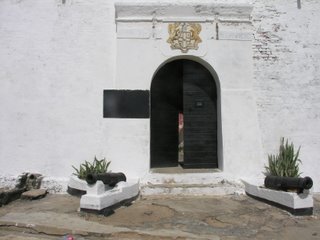 At the end of the beach was a big imposing building. It turns out it was another slave castle, called Fort William, and despite the fact that it's not open to the public, the door was ajar and we probably could have snuck a look around or found the caretaker and asked to take a look.
At the end of the beach was a big imposing building. It turns out it was another slave castle, called Fort William, and despite the fact that it's not open to the public, the door was ajar and we probably could have snuck a look around or found the caretaker and asked to take a look. I'm still kicking myself that we didn't but I just didn't know.
I'm still kicking myself that we didn't but I just didn't know.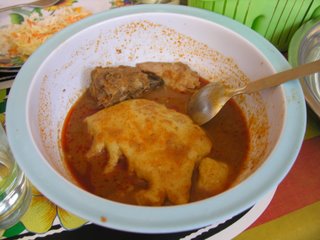
I had my first fufu in Anomabo, very tasty, the goat that came with it was a little too strong tasting for me, but I wouldn't rule out further goat eating in the future, K said that that particular goat was not very good.
After lunch we headed out to the main road, and tried to hire a car.
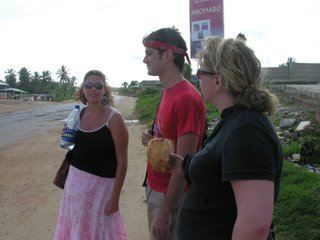 While we waited and waited for an empty car to go by, I noticed a little boy selling coconuts by the side of the road, so I decided that Ashley needed to try drinking coconut milk directly from the coconut, since we had nothing better to do. I pulled 1000 cedis out of my wallet and walked over to the kid. I asked him how much the coconut was, he said, 1000 cedis. A coconut doesn't cost 1000 cedis. So I pointed to a lady who had just bought one, and asked how much he charged her. I said that I wanted the price she had paid and not the price he charged white people. The little shit just smirked at me. I argued some more, but he just stood there smirking at me. Finally, I gave up and gave the little shit the 1000 cedis.
While we waited and waited for an empty car to go by, I noticed a little boy selling coconuts by the side of the road, so I decided that Ashley needed to try drinking coconut milk directly from the coconut, since we had nothing better to do. I pulled 1000 cedis out of my wallet and walked over to the kid. I asked him how much the coconut was, he said, 1000 cedis. A coconut doesn't cost 1000 cedis. So I pointed to a lady who had just bought one, and asked how much he charged her. I said that I wanted the price she had paid and not the price he charged white people. The little shit just smirked at me. I argued some more, but he just stood there smirking at me. Finally, I gave up and gave the little shit the 1000 cedis. 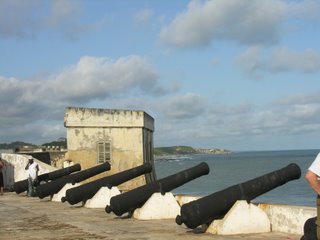 Ash got to drink about half of her coconut before we got a car. She tossed the coconut in the ditch and nearby goat made a beeline for it. Later in the trip, I was still bitching about that little shit charging me so much when it really should have only cost like 300 cedis. K came in when we were talking about it and asked me how much I had paid. I told her and she said, 'that's 10 cents.' That put everything in perspective, but still, I could have bought 3 coconuts for what I paid, little shit.
Ash got to drink about half of her coconut before we got a car. She tossed the coconut in the ditch and nearby goat made a beeline for it. Later in the trip, I was still bitching about that little shit charging me so much when it really should have only cost like 300 cedis. K came in when we were talking about it and asked me how much I had paid. I told her and she said, 'that's 10 cents.' That put everything in perspective, but still, I could have bought 3 coconuts for what I paid, little shit.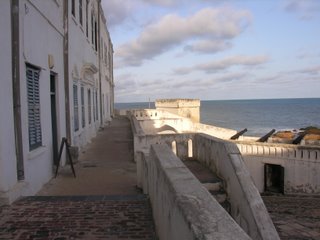 We headed for Cape Coast and had the driver drop us at Cape Castle the Unesco world heritage site, slave castle.
We headed for Cape Coast and had the driver drop us at Cape Castle the Unesco world heritage site, slave castle.The slave castles were not what I expected at all. In some ways they were so normal seeming that you wouldn't really be all that effected by it, and then be freaked out that you weren't rolling on the ground and crying and tearing your hair out over it.
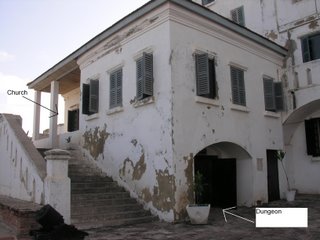 They had a school there, a church... in one case the church was over top of the slave dungeon. If that doesn't say something about organized religion, then I don't know what does. By the time the slaves got to the castle they'd have marched for as long as two months in shackles, with little to eat.
They had a school there, a church... in one case the church was over top of the slave dungeon. If that doesn't say something about organized religion, then I don't know what does. By the time the slaves got to the castle they'd have marched for as long as two months in shackles, with little to eat.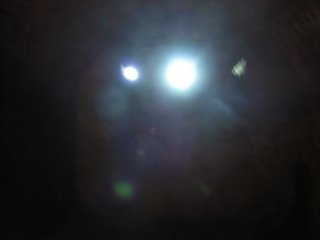 The guards at the slave castles kept the near starvation of the slaves going, because the only way to keep them subdued was when they were weak.
The guards at the slave castles kept the near starvation of the slaves going, because the only way to keep them subdued was when they were weak.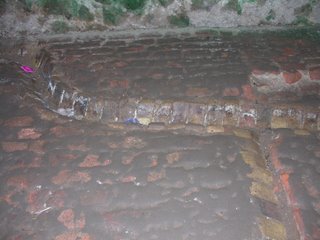 So, they gave them a meal a day. In Elmina the slaves had a bucket at either end of the small cells they were crowded into, whereas, in Cape Castle the floor was the toilet and you had to sleep in your own shit. In fact, our tour guide pointed out to us that the floors we stood on in the dungeon had been left exactly how they were when the last batch of slaves left. In the picture you can see the dirt and the drains built into the brick floor.
So, they gave them a meal a day. In Elmina the slaves had a bucket at either end of the small cells they were crowded into, whereas, in Cape Castle the floor was the toilet and you had to sleep in your own shit. In fact, our tour guide pointed out to us that the floors we stood on in the dungeon had been left exactly how they were when the last batch of slaves left. In the picture you can see the dirt and the drains built into the brick floor. 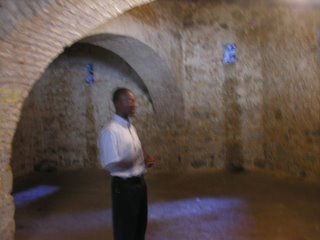 The women of course had it worse than the men. The governor and his staff raped them. The guards would drag them all out of their cells, and the governor would pick one, and she'd be washed and given a meal and sent up to his room, if she resisted when she was up there, then she'd be chained outside and shamed. If she got pregnant, she'd get to have the baby and stay in Africa, and they'd send the kid to the school in the slave castle.
The women of course had it worse than the men. The governor and his staff raped them. The guards would drag them all out of their cells, and the governor would pick one, and she'd be washed and given a meal and sent up to his room, if she resisted when she was up there, then she'd be chained outside and shamed. If she got pregnant, she'd get to have the baby and stay in Africa, and they'd send the kid to the school in the slave castle.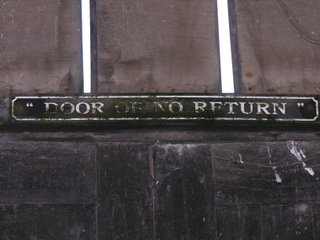 When they were being taken out of the 'door of no return' to the slave ships, often one of them would jump in the water and drown himself. Since they were all chained together, sometimes this killed people who were going to take their chances on the boat as well. It's not surprising they would do this, since many of them thought that they were being put on the ships to be food for the crews during the voyage, a logical conclusion if your jailers didn't bother to learn your language.
When they were being taken out of the 'door of no return' to the slave ships, often one of them would jump in the water and drown himself. Since they were all chained together, sometimes this killed people who were going to take their chances on the boat as well. It's not surprising they would do this, since many of them thought that they were being put on the ships to be food for the crews during the voyage, a logical conclusion if your jailers didn't bother to learn your language.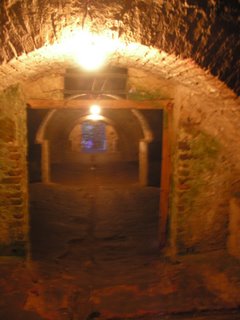
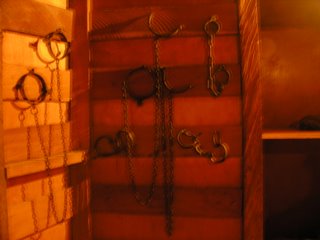 Obviously, you can't tell those kinds of stories without some emotion, but that extra emotion that an American would give to it, just isn't there. In fact, having studied this a lot already, I really wasn't feeling it, till I saw the wreaths that had been sent by different African American groups to be laid at the 'door of no return' at the slave castles.
Obviously, you can't tell those kinds of stories without some emotion, but that extra emotion that an American would give to it, just isn't there. In fact, having studied this a lot already, I really wasn't feeling it, till I saw the wreaths that had been sent by different African American groups to be laid at the 'door of no return' at the slave castles.There are lots of these buildings along the coast, most of the larger towns have them. Not all of them are open to the public. 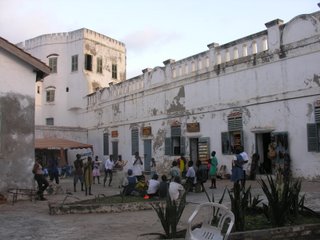 After colonialism ended, the new governments took over these buildings and continued to use them as administrative buildings, and jails, just as they had in colonial times, in fact, many of them are still jails today. Cape Castle was both a jail and open to tourists at the same time for many years.
After colonialism ended, the new governments took over these buildings and continued to use them as administrative buildings, and jails, just as they had in colonial times, in fact, many of them are still jails today. Cape Castle was both a jail and open to tourists at the same time for many years.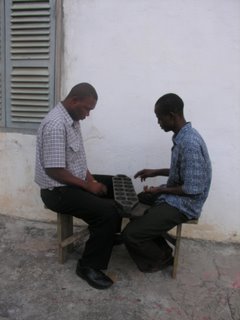 It opened to tourists in the 1970s and the jail didn't close until 1993 when they were having a visit from some important African Americans and the African Americans pointed out that the symbolism of jailing Africans in these buildings was just wrong. So the government shut the jail down and moved the prisoners elsewhere. The area where the jail was between the 70s and the 90s is now a cluster of shops. But many of these buildings are still jails. I wonder how much better the conditions are in there now, than they were in the 1700s and 1800s.
It opened to tourists in the 1970s and the jail didn't close until 1993 when they were having a visit from some important African Americans and the African Americans pointed out that the symbolism of jailing Africans in these buildings was just wrong. So the government shut the jail down and moved the prisoners elsewhere. The area where the jail was between the 70s and the 90s is now a cluster of shops. But many of these buildings are still jails. I wonder how much better the conditions are in there now, than they were in the 1700s and 1800s.
After the tour we headed into the museum which was very slick, probably a result of the Unesco money they got from being a world heritage site.
After that we wandered into the former prison and looked in the shops, we saw the local dance troup practicing, which I videoed. And, while I waited for Dan and Ashley and K to finish shopping, I found two guys playing this game that they all love in West Africa. I took a video of that too. The guy in the darker shirt wins, but I'm not sure why.
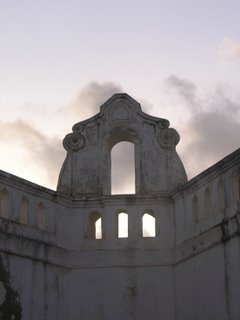
No comments:
Post a Comment